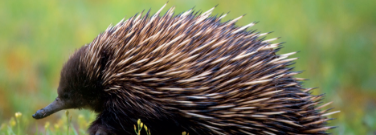How Snot Bubbles Help Echidnas Survive the Heat

By Gina Wynn
Snot is unpleasant. It makes us think of runny nosed toddlers and cold sufferers in need of a tissue. But for the Australian echidna, snot is a life saver.
In temperatures of 95° Fahrenheit or higher, short-beaked echidnas (Tachyglossus aculeatus) shouldn’t be able to survive. However, new research has shown that they are able to keep cool enough to withstand the extreme temperatures of the deserts and tropical rainforests in Australia and New Guinea by blowing snot bubbles.
When the bubbles pop, they keep the spiny mammals’ nasal passages moist, according to Christine Elizabeth Cooper and Philip Carew Withers of Curtin University and the University of Western Australia in Perth, Australia, who conducted the research. As the mucus evaporates in the echidna’s beak, it draws heat away from the critter’s blood flowing through its sinus cavity to help cool the animal. The details of the study were published in Biology Letters.
Watched in the Wild
Using infrared thermography, Cooper and Withers videotaped echidnas in Western Australian nature reserves once a month for a year. The videos revealed bright orange and yellow areas of the creatures’ bodies where they were the warmest. The tips of the echidnas’ platypus-like noses appeared as dark purple splotches, however, indicating that they were comfortably cool.
The echidnas’ spines were also purple, illustrating their insulating properties. In addition, the insides of their legs and bellies seemed to be poorly insulated, according to the report, enabling the hedgehog-like animals to shed more heat. All these avenues for heat evaporation could help regulate echidna body temperatures, which likely contributes to their higher-than-expected tolerance to hot weather.
Spiky Survivors
The research helps explain why echidnas continue to thrive in land habitats across the Australian continent, which is not the case for all its mammals. Echidnas also possess other traits not common to most mammals. They are monotremes, which means that they lay leathery eggs for reproduction instead of giving birth to live young.
Echidnas went down their own evolutionary path between 250 and 160 million years ago when the ancient Pangaea supercontinent was splitting apart. The species in Australia, New Guinea, and Tasmania—considered to be primitive types of mammals—were then geographically isolated from their more-advanced mammal competitors on other land masses, enabling them to evolve differently.
Beating the Heat
“By learning how echidnas regulate heat, we may be able to gain a betting understanding of how thermal regulation might have evolved in mammals,” said Cooper, as reported in the Science News article “These adorable Australian spike-balls beat the heat with snot bubbles” by Elise Cutts. It may also give us ideas for protecting other animal species living in warm climates as global temperatures continue to rise.
Discussion Questions
- Give examples of how other animals—including humans—regulate heat.
- Name some other animals native to Australia. What are their unique characteristics?